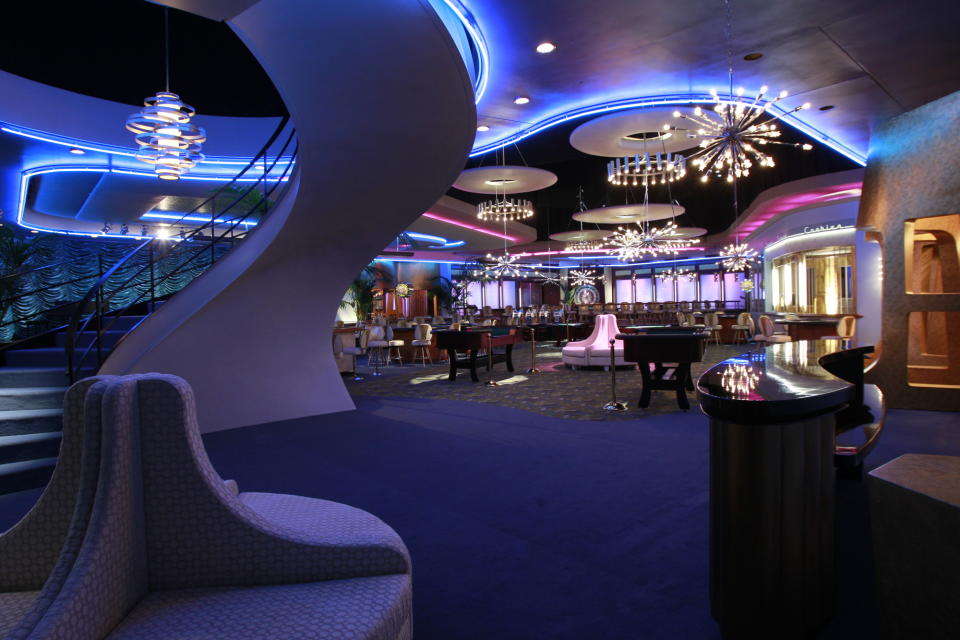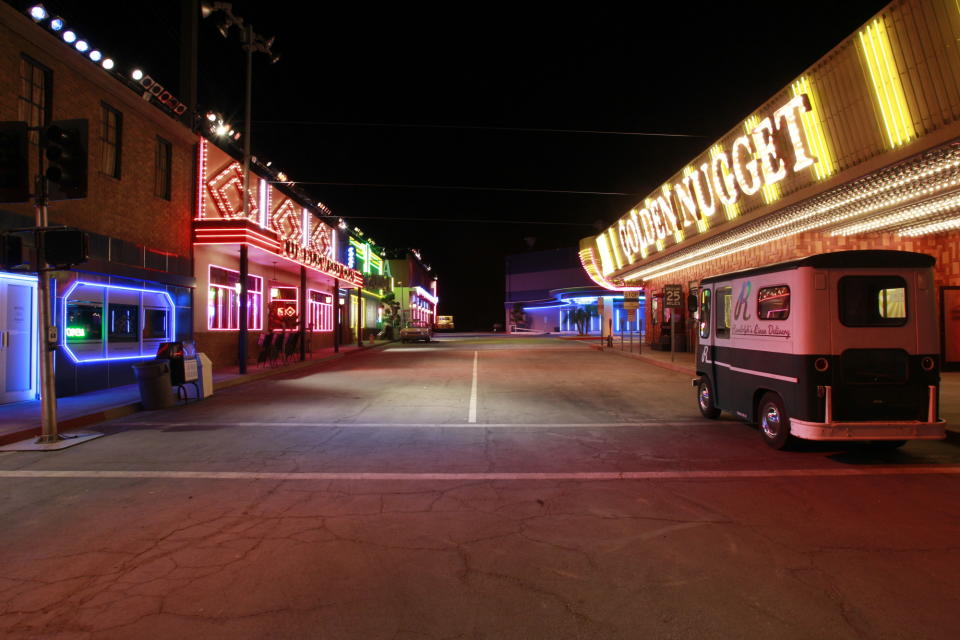Sin City of 1960 is reborn for CBS drama 'Vegas'
SANTA CLARITA, Calif. (AP) — Striding through his Las Vegas casino, tough guy Vincent Savino has a beef.
"You went behind my back to Chicago," he growls to the woman beside him. "I thought we had an understanding: You run the count room, I run the casino."
Just another day in 1960 at the Savoy, home base for CBS' new drama "Vegas."
With its Sputnik chandeliers, swooping circular stairway, pleated-fabric walls and shapely cigarette girls, The Savoy is a masterpiece of Googie architecture and Kennedy-era glamour.
And there's more.
If you were to step out its doors, you would seamlessly encounter the Vegas strip, complete with the Golden Nugget, the Tumbleweed Club and, for not-so-heavy hitters, a storefront boasting "All Day! Bingo."
Parked along the curb, of course, are vintage cars from a half-century ago.
All in all, it's an impressive time trip for a visitor to Santa Clarita Studios where, in August 2012, production is cranking up on "Vegas."
Inside Stage 1, the scene is about to be shot again with Michael Chiklis, who plays Savino, as he presides over this casino-full of 1960s-costumed gamers and staff. It's the very first day filming on the 14,000-square-foot Savoy set, which, along with the replica of Fremont Street outside, existed only as blueprints, empty studio space and a slab of parking lot just a few weeks ago.
(The pilot for "Vegas," which airs Tuesday at 10 p.m. EDT, was shot last spring on locations in New Mexico, so this permanent new home won't be seen until the second episode.)
The Strip ends abruptly at a bluff as a hot wind rushes past. But the huge green scrim will allow for CGI effects to extend "Fremont Street" into an illusory distance.
The job called for more than being pretty.
"Everything on the street had to be specially engineered," says the show's production designer, Carey Meyer, standing in the neon-glowing Savoy entrance. "Each pole of those facades goes into the ground 15 feet, because the wind load up here is just tremendous. And there's also the risk of earthquakes."
Inspired by a true story, "Vegas" stars Chiklis as the Chicago mobster sent to run the recently opened Savoy — and who will butt heads with Las Vegas Sheriff Ralph Lamb, a fourth-generation rancher who's intent on keeping growth and corruption from spoiling his town. The real-life Lamb is portrayed, two-fisted and laconic, by Dennis Quaid.
"It's going to be an interesting dance between us," says Chiklis. "You know the end of the story: Vegas grew and Vegas was successful. But how did it get that way, especially when Lamb and my character are so culturally different and diametrically opposed in so many ways?"
Chiklis has brought his own camera to the set on this first day in residence. He shares with a reporter some of the photos he's been snapping between scenes.
"They look like they could have been shot back in the day, right?" he says.
Clearly, Chiklis is pleased with his surroundings. That's fortunate. If "Vegas" clicks with viewers, this could be his hangout for many seasons to come.
But he isn't the only "Vegas" member who's happy with its back-in-time environment.
"It's a hoot," says executive producer Greg Walker, "walking out there and seeing the extras in their outfits, and those cars and the facades. I'm pinching myself. I hadn't anticipated this kind of rush!"
Walker's office in the Stage 1 building overlooks a freeway down below and, beyond it, Santa Clarita, a city of 175,000 some 30 miles north of L.A.
"What first appealed to me about the show was its idea of Vegas I hadn't seen anybody cover before," says Walker. "We've seen Vegas before then in 'Bugsy' and 'The Godfather,' and post-1960s in 'Casino.' But what it finally came down to was the allure of Ralph Lamb as a character trying to preserve what he loved about the city, against the tidal wave of gangsters from Chicago and the East Coast."
"It's cowboy hats vs. the fedoras," sums up Nicholas Pileggi, a fellow executive producer. Pileggi is the much-acclaimed crime reporter who wrote the books from which he adapted the screenplays for "Goodfellas" and "Casino." He's an expert on Vegas and its dark but dazzling history.
That history is fueling the new series, which, according to Walker, "calls for mixing procedural television with a saga of rich characters in a Dickensian sprawl — and doing all that in 42 minutes each episode."
Walker, whose credits include "Without a Trace" and "Smallville," says crafting such a hybrid is the biggest challenge facing "Vegas" — and not, as you might think, the difficulty and expense of its period detail.
"The period was never daunting for me," he says, "nor was it the reason to do the show. Our mantra is, 'It's not about the tail fin of the Cadillac.'"
Then, sympathetically invoking "The Playboy Club" and "Pan Am" — two circa-1960s TV dramas that flopped last season — Walker adds, "We're not selling a period. We're not selling a club or an airline. We're selling characters and the world we believe in: 1960 Las Vegas."
It's a world alive and well these days in Santa Clarita.
___
CBS is a division of CBS Corp.
___
EDITOR'S NOTE — Frazier Moore is a national television columnist for The Associated Press. He can be reached at fmoore(at)ap.org and at http://www.twitter.com/tvfrazier



